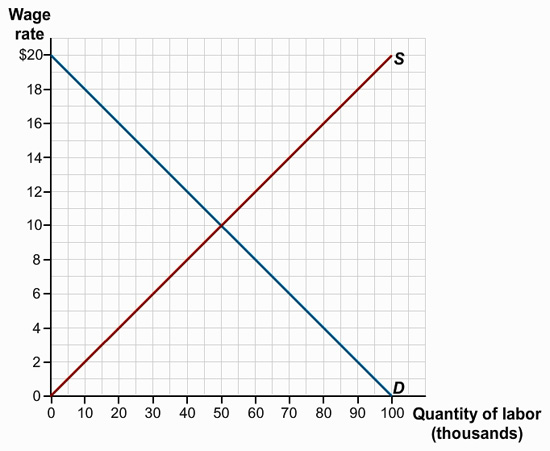Question 1 of 4
Step 1
There is only one labor market in Profunctia. All workers have the same skills, and all firms hire workers with these skills. Use the accompanying diagram, which shows the supply of and demand for labor, to answer the following questions.

What is the equilibrium wage rate in Profunctia? At this wage rate, what are the level of employment, the size of the labor force, and the unemployment rate?
Equilibrium wage: $
Level of employment:
Labor force:
Unemployment rate: percent
- Chapters
- descriptions off, selected
- captions settings, opens captions settings dialog
- captions off, selected
- English Captions
This is a modal window.
Beginning of dialog window. Escape will cancel and close the window.
End of dialog window.
This is a modal window. This modal can be closed by pressing the Escape key or activating the close button.
This is a modal window.
Step 2
If the government of Profunctia sets a minimum wage equal to $12, what will be the level of employment, the size of the labor force, and the unemployment rate?

Level of employment:
Labor force:
Unemployment rate: percent
- Chapters
- descriptions off, selected
- captions settings, opens captions settings dialog
- captions off, selected
- English Captions
This is a modal window.
Beginning of dialog window. Escape will cancel and close the window.
End of dialog window.
This is a modal window. This modal can be closed by pressing the Escape key or activating the close button.
This is a modal window.
Step 3
If unions bargain with the firms in Profunctia and set a wage rate equal to $14, what will be the level of employment, the size of the labor force, and the unemployment rate?

Level of employment:
Labor force:
Unemployment rate: percent
- Chapters
- descriptions off, selected
- captions settings, opens captions settings dialog
- captions off, selected
- English Captions
This is a modal window.
Beginning of dialog window. Escape will cancel and close the window.
End of dialog window.
This is a modal window. This modal can be closed by pressing the Escape key or activating the close button.
This is a modal window.
Step 4
If the concern for retaining workers and encouraging high-quality work leads firms to set a wage rate equal to $16, what will be the level of employment, the size of the labor force, and the unemployment rate?

Level of employment:
Labor force:
Unemployment rate: percent
- Chapters
- descriptions off, selected
- captions settings, opens captions settings dialog
- captions off, selected
- English Captions
This is a modal window.
Beginning of dialog window. Escape will cancel and close the window.
End of dialog window.
This is a modal window. This modal can be closed by pressing the Escape key or activating the close button.
This is a modal window.